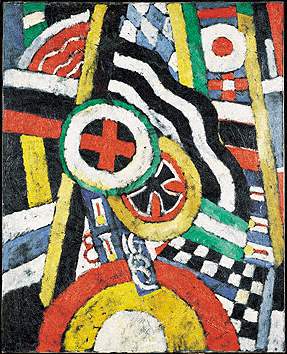|
|

Marsden Hartley,
Number
5, 1914-15 |
|
English 628: Studies
in 20th C. American Literature:
The New York Avant-Garde, 1913-1929
Fall 2003
Prof. Joseph Conte
This seminar will address the formation
of a New York Avant-Garde during the period between the Armory
Show of 1913 and the Stock Market crash of 1929. The collocation
of poets, composers, artists, and photographers in and around
Manhattan creates an early nexus of American modernism that both
borrowed from and sought to distinguish itself from European
modernism. Although Ezra Pound, Gertrude Stein, and T.
S. Eliot had already departed a "half-savage" country
for London and Paris, French artists such as Francis Picabia
and Marcel Duchamp sought refuge in New York from conscription
during World War I. The advent of Post-Impressionist, Cubist
and Dadaist art in America-introduced with scandalous success
at the Armory Show and the Independents Exhibition of 1917-stirred
the sedate arts community in New York. As William Carlos
Williams recalls, "it was not until I clapped my eyes on
Marcel Duchamp's Nude Descending A Staircase that I burst
out laughing from the relief it brought me." The new
European art movements collide with the raw commercial and industrial
power of an American city, with its skyscrapers, mechanization,
and violent pursuit of business. The New York Avant-Garde
is born of this confrontation. One focus of attention will
be the Others group, founded by the poet Alfred Kreymborg
and photographer Man Ray, that brought the local American writers
and artists into collaboration with European emigree artists
in flight from the destruction of the first World War.
Among the work by members of this collective centered in Grantwood,
NJ, we will read William Carlos Williams's early poetry and his
improvisatory compositions in Kora in Hell (1920).
In her early poetry Marianne Moore describes New York as "the
savage's romance / accreted where we need the space for commerce."
In her bricolage of text and observation, she finds "it
is not the atmosphere of ingenuity . . . but 'accessibility to
experience'" that compels her lifelong residence in New
York. A second overlapping circle formed around the wealthy patron
Walter Conrad Arensberg, in whose West 67th St. apartment Marcel
Duchamp worked on the Large Glass (1915-23). Arensberg
introduces Wallace Stevens to Duchamp, and the flamboyance of
Stevens's first book, Harmonium (1923), owes much to this
connection. Mina Loy, a frequent contributor to Others
and an associate of Arensberg, composes the poetry of the New
Woman in Lunar Baedecker (1923), declaring open revolt
against patriarchal prescriptions of the female artist and sexuality.
Alfred Stieglitz's 291 gallery on Fifth Avenue and the
journal Camera Work served as a principal meeting place
for photographers, artists, and writers. We will examine
the formulation of American precisionism in the work of Charles
Demuth and Charles Sheeler, and in the prose and poetry of Williams's
Sour Grapes (1921) and Spring and All (1923).
Marsden Hartley's poetry and painting from this period offer
a useful point of comparison for developments and cross-fertilizations
in both arts. Finally, we'll listen to the articulation
of an American voice in the collaboration of Virgil Thomson (in
New York) and Gertrude Stein (in Paris) on the opera Four
Saints in Three Acts (1928).
The requirements for the course are a twenty-page research paper
relevant to the issues and authors described above, and a twenty-minute
presentation on an issue of critical interest to the class, accompanied
by a short synopsis for distribution to class members.
Last Revised on Monday, August 11, 2003
Course Materials
are copyright © Joseph M. Conte 2003 All Rights Reserved |